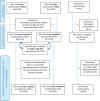Nursing students'knowledge and effectiveness of teaching in infection prevention and control
- PMID: 40615900
- PMCID: PMC12228198
- DOI: 10.1186/s12912-025-03316-1
Nursing students'knowledge and effectiveness of teaching in infection prevention and control
Abstract
Introduction: In order to prevent healthcare-associated infections, infection prevention and control (IPC) is taught to nursing students in France as soon as they enter the nursing training institutes. The primary objective of this study was to assess the knowledge of standard precautions and hand hygiene of French nursing students before and after training. Secondary objectives were to measure factors predicting success on knowledge tests, and to investigate the effectiveness of the different teaching techniques used.
Materials and methods: A quantitative study using online self-administered questionnaires was performed between September 1, 2022 and March 7, 2023 in French nursing training institutes. Three self-administered questionnaires were administered: the first to IPC trainers on their teaching methods, and the next two to nursing students on their knowledge and socio-demographic characteristics, with one questionnaire before and one after IPC training.
Results: Fifty-nine nursing training institutes took part in the study. Before and after IPC training, 3,739 and 2,378 nursing students participated, respectively. At the start of training, the mean score on the knowledge test was 35.67 out of 50 ([35.53-35.77] sd = 3.76), i.e. a moderate level of knowledge. After IPC training, the mean score on the knowledge test was 37.55 out of 50 ([37.40-37.68] sd = 3.48), i.e. a good level of knowledge. Students with a Nursing Auxiliary Diploma (NAD) scored significantly better than no NAD students, both before (p˂0.001) and after (p˂0.001) IPC training. The teaching techniques used were varied and combined, but only practice audits significantly improved students' knowledge after training (p = 0.050).
Discussion: Nursing students' knowledge of IPC before training is heterogeneous and moderate. After training, knowledge had improved little but significantly. Only auditing was effective to improve students' level of knowledge of IPC. Audits should be included in the IPC training program.
Keywords: Hand hygiene; Infection prevention and control; Nursing education; Standard precautions; Teaching.
© 2025. The Author(s).
Conflict of interest statement
Declarations. Ethics approval and consent to participate: Research was conducted in compliance with the Helsinki Declaration. The clinical research direction of Grenoble Alps University Hospital in France classified the survey as a RNIPH (Research Not Involving the Human Person) according to the French research methodology (MR-004). Only informed consent to participate was obtained from all of the participants. Consent for publication: Not available. Competing interests: The authors declare no competing interests.
Figures




Similar articles
-
Intravenous magnesium sulphate and sotalol for prevention of atrial fibrillation after coronary artery bypass surgery: a systematic review and economic evaluation.Health Technol Assess. 2008 Jun;12(28):iii-iv, ix-95. doi: 10.3310/hta12280. Health Technol Assess. 2008. PMID: 18547499
-
Home treatment for mental health problems: a systematic review.Health Technol Assess. 2001;5(15):1-139. doi: 10.3310/hta5150. Health Technol Assess. 2001. PMID: 11532236
-
The educational effects of portfolios on undergraduate student learning: a Best Evidence Medical Education (BEME) systematic review. BEME Guide No. 11.Med Teach. 2009 Apr;31(4):282-98. doi: 10.1080/01421590902889897. Med Teach. 2009. PMID: 19404891
-
Interventions to prevent misconduct and promote integrity in research and publication.Cochrane Database Syst Rev. 2016 Apr 4;4(4):MR000038. doi: 10.1002/14651858.MR000038.pub2. Cochrane Database Syst Rev. 2016. PMID: 27040721 Free PMC article.
-
Systemic pharmacological treatments for chronic plaque psoriasis: a network meta-analysis.Cochrane Database Syst Rev. 2021 Apr 19;4(4):CD011535. doi: 10.1002/14651858.CD011535.pub4. Cochrane Database Syst Rev. 2021. Update in: Cochrane Database Syst Rev. 2022 May 23;5:CD011535. doi: 10.1002/14651858.CD011535.pub5. PMID: 33871055 Free PMC article. Updated.
References
-
- WHO. WHO guidelines on hand hygiene in health care: a summary. 2009 [cited 2024 Aug 21]; Available from: https://www.who.int/publications/i/item/9789241597906
-
- Alison D, Lydecker PA, Osei L, Pineles JK, Johnson J, Meisel OC, Stine L, Magder AP, Gurses. Joan hebden, Cagla oruc, Lona mody, Kara Jacobs slifka, nimalie D stone, Mary-Claire roghmann. Targeted gown and glove use to prevent Staphylococcus aureus acquisition in community-based nursing homes: A pilot study. Infect Control Hosp Epidemiol. 2021;42(4):448–54. - PMC - PubMed
-
- Mast ST, Woolwine JD, Gerberding JL. Efficacy of gloves in reducing blood volumes transferred during simulated needlestick injury. J Infect Dis. 1993;168(6):1589–92. - PubMed
-
- Pittet D, Hugonnet S, Harbarth S, Mourouga P, Sauvan V, Touveneau S, et al. Effectiveness of a hospital-wide programme to improve compliance with hand hygiene. Infect Control Programme Lancet Lond Engl. 2000;356(9238):1307–12. - PubMed
-
- Bouget Mohammedi S, Landelle C. Review of literature: knowledge and practice of standard precautions by nursing student and teaching techniques used in training. Am J Infect Control. 2023;51(5):574–81. - PubMed
LinkOut - more resources
Full Text Sources

